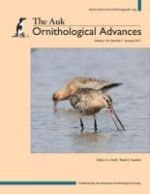The strategies by which foraging predators decide when to redirect their gaze influence both prey detection rates and the prey's ability to detect and avoid predators. We applied statistical analyses that have been used to study neural decision-making for gaze redirection in primates to 3 species of predatory birds with different sizes, visual systems, habitats, and hunting behaviors: the Northern Goshawk (Accipiter gentilis), Cooper's Hawk (A. cooperii), and Red-tailed Hawk (Buteo jamaicensis). The timing of head saccades was measured during visual searches using field video recordings of foraging raptors, and during a variety of behaviors using a miniature camera mounted on the head of a Northern Goshawk. The resulting statistical distribution of latencies (time between successive head saccades) was compared to predictions from various models proposed to describe visual search strategies. Our results did not support models that assume a constant probability of gaze redirection per unit time, a constant time for “giving up” on the visual search, or an initial setup time before visual search initiation. Instead, our data were fit best by a log-normal distribution, consistent with the raptors stochastically changing their gaze direction on the basis of accumulated environmental information. Specifically, this suggests that saccade initiation arises from a neural computation based on detection of a threshold level of a dynamically updated decision signal that encodes noisy sensory data, similar to the processes inferred from previous studies of visual search strategies in primates. The only significant between-species difference we found was a slower mean gaze-redirection rate for 2 larger species compared to the Cooper's Hawk, even though the latter has hunting behavior and maneuverability similar to that of the Northern Goshawk. Head-saccade latencies measured for a Northern Goshawk during different behaviors showed that the bird changed gaze direction significantly less frequently, on average, while perched than while in motion.
How to translate text using browser tools
16 November 2016
Sneak peek: Raptors search for prey using stochastic head turns
Michael F. Ochs,
Marjon Zamani,
Gustavo Maia Rodrigues Gomes,
Raimundo Cardoso de Oliveira Neto,
Suzanne Amador Kane

The Auk
Vol. 134 • No. 1
January 2017
Vol. 134 • No. 1
January 2017
foraging
latency
neural decision-making
predator
raptors
saccade
searching




